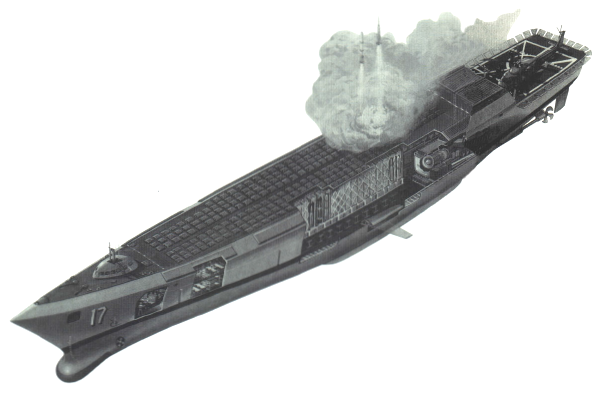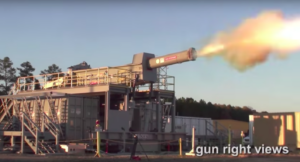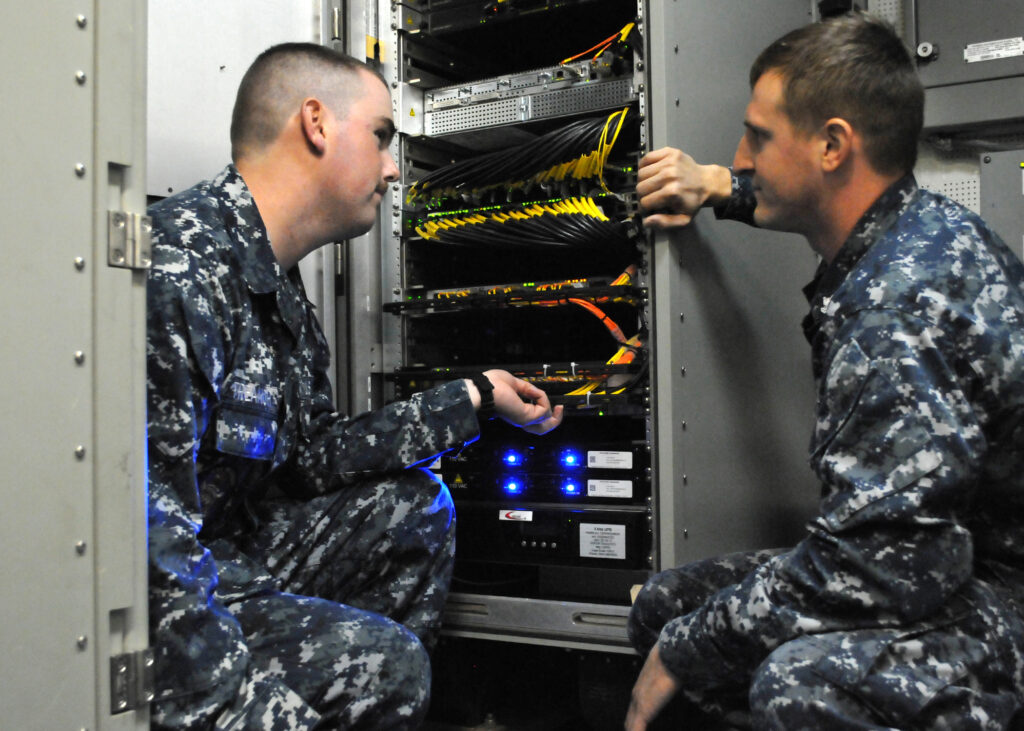Robot Wolfpacks: The Faster, Cheaper 355-Ship Fleet
Posted on
ARLINGTON: The Navy’s future frigates and cruisers will sail into battle next decade accompanied by flotillas of smaller, expendable robotic craft, leading admirals said last week. It’s a big bet on small ships and high tech to get the fleet up to the 355 vessels the Navy says it needs to counter Russia and China, an armada which would take decades to build the traditional way.
“Part of the value of having unmanned surface vehicles is you can get capacity at a lower cost,” Rear Adm. John Neagley, the Navy’s Program Executive Officer for Unmanned & Small Combatants, told me Thursday. It’s a 21st century take on the classic military dilemma between capability, which drives you to a small number of powerful but expensive ships, and capacity, which drives you to a large number of cheap but fragile craft.
If artificial intelligence can replace humans on the most vulnerable vessels, and robust networks can link manned and unmanned ships into a single coherent force – without succumbing to hacking or jamming – maybe you can get the best of both worlds. And since a robotic ship can be a lot smaller than a comparable equipped manned one – which needs living quarters and protection for a human crew – they can be built in a wider range of smaller shipyards beyond the big five that dominate shipbuilding today (Bath, Electric Boat, Ingalls, Newport News, and NASSCO).
“There’s opportunity for a number of shipbuilders in the unmanned [program],” Neagley told me in an impromptu interview on the sidelines of last week’s Surface Navy Association conference. “That’s all open. We’re interested in competition.”
What Does What?
The concepts for the future are still evolving, but the likely division of labor looks three-fold:
- Medium-sized Unmanned Surface Vessels (USVs), about the size of the experimental 132-foot Sea Hunter launched in 2016, will act as scouts and decoys, carrying sensors and jammers for what the Navy calls Electromagnetic Maneuver Warfare. If their radio and radar emissions draw enemy fire, well, they were relatively cheap and there’s nobody aboard to get killed.
- Larger USVs, approaching the size of conventional corvettes, will provide additional punch, loaded with missile launchers but relying on other vessels to find the enemy and relay targeting data – a concept similar to the Arsenal Ship cancelled 20 years ago. The Navy wants to award a large USV contract by 2023, Neagley said.
- The manned ships will bring both the tactical adaptability of the human brain – still unmatched by any computer – and sensors and weapons systems too big to fit on the robotic craft, like high-powered radars and railguns.
There’s a reason why the robotic vessels start at size “medium”: Yes, small unmanned surface vessels also exist, but they’re basically boats that can’t make long ocean voyages on their own. By contrast, when it comes to the medium and larger USVs in this vision, “they are ships,” Neagley told the conference. “There’s autonomy built in, there’s redundancy… so they can operate alone and unafraid without a lot of intervention.”
That said, even the largest unmanned vessels will be smaller than any manned surface combatant, Neagley said. Those crewed craft range from today’s Littoral Combat Ships and destroyers to the future frigate, for which the production contract will be awarded in 2020, and the Large Surface Combatant – closer to a cruiser than a destroyer – to be awarded in 2023-2024. A formal Request For Information, asking industry for their input on the cruiser, will be out in “days,” said the Navy’s Program Executive Officer for Ships.
The Navy has done “a lot of work …over the last six or seven months,” Rear Adm. William Galinis, PEO-Ships, told the Surface Navy Association on Thursday. “We’ve got a set of RFIs [that] we’re going to be putting out here probably in the next few days to industry to really start that process, put some proverbial meat on the bones.”
So, I asked, what role will the future cruiser fill in the fleet? Rear Adm. Ron Boxall, director of surface warfare on the Navy staff, and the Chief of Naval Operations himself, Adm. John Richardson, “challenged us” on that very question, Galinis replied.
“What are the functions that only a large ship can bring to the fight?” Galinis continued. Even in the age of iPhones, size still matters. Only large ships can accommodate the largest antenna arrays for long-range, high-powered, highly sensitive radar and radio systems, he said. And, the admiral added, “the hull size itself allows you maybe to incorporate larger weapons, whether they be missiles or gun systems.”
Galinis didn’t specify what weapons he meant. But even corvette-sized ships like LCS can accommodate at least a few of the Navy’s standard heavy-duty missile tubes, the Mark 41 Vertical Launch System (VLS). Meanwhile any push for larger conventional cannon seem to have reached a dead end with the 155 mm guns on the DDG-1000 Zumwalt class, for which there is no affordable ammunition. Those two facts suggest Galinis is thinking of future weapons that might require more space and, even more important, electrical output than small ships could provide. The options range from missiles too big for VLS to high-powered lasers and railguns.
All this suggests (but hardly guarantees) the future cruiser would be the far-seeing, hard-hitting flagship of the fleet. But where does the frigate fit in? What can such a relatively small manned ship do that the larger unmanned vessels cannot?
First of all, Neagley told me, the frigate’s still going to be a lot larger than the “large” USV, which the Navy envisions as longer than 50 meters (164 feet) but smaller than the 120-plus meters (about 400 feet) typical of frigates. The combination of a larger hull and, equally important, human beings aboard means the frigate can be much more flexible than the ro-boats.
“The frigate is a multi-mission surface combatant,” Neagley said, able to hunt submarines, shoot down enemy aircraft, and fight enemy surface vessels. By contrast, he continued, each unmanned surface vessel will “probably” specialize in a single mission.
The Littoral Combat Ship, 118 or 128 meters long depending on the variant, is an interesting hybrid: It was designed to do only one mission at a time – hunting subs, mines, or fast attack boats – but using mission modules for each role that can be swapped out between voyages.
Commonality & Compatibility
In recent years, the Navy has moved away from the mission module approach, and it now plans to dedicate each Littoral Combat Ship to one of the three missions for its entire service life. But the service is still keen on designing new ships with modular systems – from software to weapons – that can be replaced or upgraded without a major overhaul, ideally using as many components as possible on multiple classes of ship rather than reinventing the wheel (or the bilge pump) for each type. This design approach, often called open architecture, will be important for the frigate and probably the cruiser and unmanned combatants as well, as will moving from traditional gas turbines to electric drives that can generate the vast amounts of power required.
While the new frigate will be based on an existing design, with three of the five contenders already serving in allied navies, the Navy is “very purposefully” requiring the installation of a large amount of Government-Furnished Equipment (GFE) to ensure commonality with other classes, Neagley said. Such standardization across the fleet is needed not just to keep down costs but to ensure different ships’ systems are compatible.
Compatibility, in turn, is a crucial for a distributed fleet that must share threat and target data across widely scattered vessels – many of them with no human aboard to exercise tactical judgment if communications fail.
“They all need to be interoperable,” Neagley told the conference. His office and the Program Executive Office for Integrated Warfare Systems are working closely together, he said, “to make sure all this is knitted together in whatever the tactical mesh is that allows us to communicate across multiple manned and unmanned systems.”
“We can improve our naval power immediately … by stitching together things that we have today,” added Rear Adm. Douglas Small, who heads PEO-IWS. “We’re working really hard on concepts like integrated fire control, expanding that out to every disparate platform we have out there, just expand our reach and really take advantage of this concept of distributed maritime operations.”
In the near term, Small said, “you will see things like CEC (Cooperative Engagement Capability) and Link-16 and any other type of existing means of exchanging information between the systems.” In the long term, he went on, the objective is a “communications as a service” approach in which the network is agnostic to the hardware on any specific ship and “we wouldn’t care which link we’d be using.” But there’s a lot we can do with today’s technology, he emphasized.
The Navy’s working on networks that can pull data from multiple ships into a single coherent picture, Small told me after the panel. That includes the possibility of so-called multi-static radar in which only one ship transmits an active pulse (making it a target) while the rest passively listen.
“We’re still working through… how specifically we’re going to use these things,” Small told me. What’s crucial is to get the technology to the fleet, quickly, so real crews can experiment with it in real-world conditions. We may have in our small minds some idea of how this thing’s going to be used,” he said, “but when you turn it over to the sailors, they’re going to have a whole new, awesome way of using it.”
Subscribe to our newsletter
Promotions, new products and sales. Directly to your inbox.






